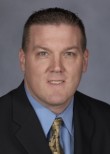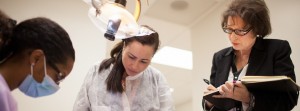 Sixteen years ago, Linda Behar-Horenstein, a distinguished scholar and professor in UF’s College of Education, was teaching a course on curriculum. What she didn’t know was that one of her students was going home at night and enthusiastically talking about it to her husband, who happened to be the associate dean of research for the College of Dentistry. Word soon traveled, and Behar-Horenstein received an invitation from then dean Frank Catalanotto to meet.
Sixteen years ago, Linda Behar-Horenstein, a distinguished scholar and professor in UF’s College of Education, was teaching a course on curriculum. What she didn’t know was that one of her students was going home at night and enthusiastically talking about it to her husband, who happened to be the associate dean of research for the College of Dentistry. Word soon traveled, and Behar-Horenstein received an invitation from then dean Frank Catalanotto to meet.
“The meeting wasn’t even two minutes,” she says. “He said, ‘OK, this what I would like you to do. I want you to go out to all the clinics and I want you to find out to what degree are the faculty promoting critical thinking skills among our students.’ That was my assignment.”

COE professor Linda Behar-Horenstein (left) observes a dentistry professor and student during a patient visit. (Photos by Maria Farias/UF&Shands)
Armed with only a notepad, Behar-Horenstein conducted 44 observations at six clinics. She watched dental faculty work with students as they themselves worked with patients, and she scribbled down everything she saw them say and do. When she was done, she analyzed her notes for commonalities, characteristics, recurring behavior and techniques. Then she brought her findings to the associate dean of education.
“She was just like, ‘You got this all from an observation?’”
Thus began Behar-Horenstein’s long relationship with the College of Dentistry. Over the years, she’s taught dentistry faculty alongside her graduate education students, run seminars on different teaching methodologies, written 10 papers pertaining to dentistry and worked one-on-one with dentistry faculty who want to improve their teaching evaluations.
Education and health care: It’s an odd match of disciplines, at least at first glance. The College of Education conjures up images of lesson plans, curricula and schoolteachers in training. For the six colleges in UF’s Health Science Center, people think of labs, white coats or hospital corridors.
Both disciplines are more diverse and expansive than a few clichés capture — but it may still be surprising how often the College of Education teams up with UF’s health colleges. Education students work in clinical practices. Education faculty share office space with health-focused colleagues. They partner with health care researchers on grants, contribute to health curricula and teach everyone from doctors to dentists how to be better teachers. They show health care professionals the world through the lens of a classroom.
“Any time two disciplines overlap, you have a possibility to create something completely new,” says David Norton, UF’s vice president for research. “With the Health Science Center, education is essential to their mission — educating students and their patients. In the College of Education, you have people who focus on just that. Very interesting things can emerge when those two things combine.”
Teaching teachers
So why is it worthwhile to develop the teaching skills of clinicians and researchers in the first place?
“What we do in our teaching is going to impact the kind of provider that’s going out into the world,” Behar-Horenstein says. “And that provider is going to impact the kind of patient-provider relationships they have.”
During her time with the College of Dentistry, Behar-Horenstein has gone from being a consultant to an affiliate professor, and last year she even received an office as part of a federal grant that expanded her role further. Recently, she developed a series of online courses for faculty that focus on teaching techniques.
“We as faculty are trained to be dentists, but we don’t have a special knowledge of teaching,” says Catalanotto, a professor and chair of community dentistry and behavioral science. “So having a collaborator like Dr. Behar-Horenstein brings us a new set of skills. That’s why we originally asked her to come the college in 1996, because we recognized that we needed help with teaching issues.”
Kent Crippen is another education professor who’s helping educators expand their repertoire, but in this case, it’s high school teachers.
Crippen is a consultant for Biomedical Explorations: Bench to Bedside, a two-week summer program for high school science teachers. The program is part of the Center for Precollegiate Education and Training, which connects educators to more than 350 UF faculty researchers to promote math and science in secondary school classrooms.
Crippen, an associate professor of science, technology, engineering and mathematics, or STEM, education, uses his knowledge of the K-12 school system to help translate the projects for classroom use.
“We struggle in K-12 education to present authentic science experiences that students can engage in, enjoy and learn from at the same time,” Crippen says. “Bench to Bedside takes new and emerging science and translates it to appropriate experiences for students to learn from.”
Through the center’s programs, high school teachers can stay current with modern technology and teaching techniques. The program, now in its third year, is expanding to support small groups of teachers throughout Florida who want to continue the professional development initiated in the program. Crippen will help them develop curricula and measure results and feedback.
Small group work
When asked what his typical day looks like, Erik Black, Ph.D., pauses, then laughs.
“I have three offices.”
There’s the cubicle at Shands at UF, the pediatric outpatient clinic office, and the office at the College of Education. In other words, there aren’t a lot of typical days for this assistant professor, who’s held a primary appointment in pediatrics and a secondary appointment in the College of Education since 2009. Black teaches and has graduate education students and does his own research for pediatrics.
“While many people traditionally think about the College of Education in a K-12 format, there are a number of us who are actively involved in adult education, and that’s where I focus most of my career: how to effectively educate adults,” Black says.
He’s currently serving as the educational technology expert for the Interdisciplinary Family Health course, which brings 600 first-year students from six colleges together to visit and help local families. At the end of last year, the program was expanded to include second-year students, and Black was involved from the beginning stage, developing basic goals, through the design and delivery of the curriculum.
“There is a real desire on the part of the administration to continue more interprofessional learning experiences,” Black says. “So this is a real opportunity, since we’ve got six health science colleges within a couple blocks of each other, to get students working together.”
UF has programs in place specifically designed to encourage interdisciplinary research, Norton says. The Research Opportunity Seed Fund, for example, is an internal grant program specifically for interdisciplinary faculty research.
“We’re always interested in creating forums and venues where people can interact,” he says. “It’s one of the strengths of the University of Florida that we have 16 colleges on campus, most of them with strong research programs. New fields emerge.”
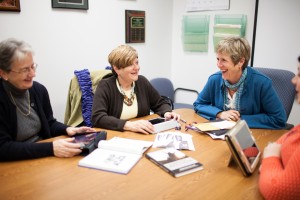
COE professor Jeanne Repetto (second from left) meets with an interdisciplinary team of “transition” health-care specialists from UF&Shands.
The Education and Health Care Transition certificate program emerged last summer under just such a collaboration. Four years ago, Jeanne Repetto, an associate professor in the College of Education, and social worker Susan Chauncey Horky, the co-director of the UF Pediatric Pulmonary Center, realized educators and health care professionals were approaching the same problem at two different angles — when instead, they should be working together.
The problem was “transition,” a term to describe how children with disabilities and/or health issues are prepared to succeed in adult life. From the educational standpoint, these children receive support and training at school to tackle transitioning into a university or job, as well as life skills. From the health care standpoint, children are likewise prepared to handle medical needs, such as ordering prescriptions and making appointments.
These two types of transition often operate independently of one another, with both sides unaware of the other, Horky says.
“I was sort of embarrassed when I realized there was a whole transition process in education,” she says. “You do get stuck in your own mindset — we tend to think in the patient mode and the school thinks in the student mode. But from the family’s perspective, it’s only one kid going from childhood to adulthood, so why are these skills not integrated?”
Horky, Repetto and a small, interdisciplinary team including a pediatric cardiologist, a medical social worker, a health policy expert and a parent of a child with a chronic illness, started working to integrate the two transitions.
Years of biweekly meetings, joint research, journal articles, grant proposals and national presentations culminated in the Education and Health Care Transition program, a fully online certificate from UF that prepares graduate students and professionals from both fields to collaborate. It’s a new field, and the first class of medicine and education students from across the country will graduate this semester.
“Many of the students in the program are practitioners, so it will have an immediate impact,” Repetto says.
From the clinic to the classroom
It’s probably not that surprising that most collaborations between the Health Science Center and the College of Education involve the department of pediatrics. After all, children with disabilities often need help from clinical professionals to succeed in school — and sometimes those professionals need help bringing their findings into the classroom.
“Collaborators with educational backgrounds, particularly those related to childhood — childhood education, how children learn, how they adapt to their environments — have real expertise that we can learn from as we develop programs in our department,” said Scott Rivkees, a professor and chair of pediatrics.
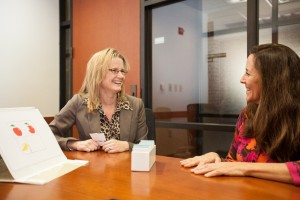
UF neuropsychologist Kristin Radonovich (left) and COE professor Maureen Conroy (right) often meet at Norman Hall to discuss their grant project.
Maureen Conroy, says that finding collaborators is like making friends; you look for similar interests. For Conroy, a College of Education professor, that interest was autism research.
It led her to seek out others on campus with the same interest, like neuropsychologist Krestin Radonovich. The two recently teamed up on an Office of Research grant to improve the social competence of children with autism spectrum disorders.
“To teach children social skills, they need to socially interact with other people,” says Conroy, co-director of UF’s campuswide Center for Excellence in Early Childhood Studies, headquartered at the College of Education. “Kids in the lunchroom or the playground usually play with each other, but children with autism don’t necessarily know how to do that. They stand by themselves. This will teach them how to play with the other children and will also teach the other children how to play with them.”
Their project is currently in the planning phase, but eventually Conroy and Radonovich will take strategies that promote social behavior directly into schools and work with children with autism.
Testing out strategies that were developed in clinics in schools is part of what makes this study unique, Radonovich says. It’s also where Conroy’s expertise comes in.
“For kids, their everyday life is largely at school and that’s where these interactions take place,” Radonovich says. “I want my work to be relevant, so to work with Dr. Conroy in a naturalistic school setting helps me to bridge that gap between the isolated clinic setting and real life for these kids.”
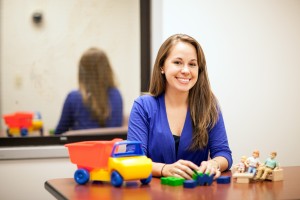
School psychology student Jill Welsh uses toys while working with children in the psychology clinic at UF&Shands.
The College of Education also makes its mark in UF and Shands clinics. Several doctoral students in the school psychology program work in the pediatric clinic to gain experience working with children.
“I realized that working with kids who have a communication deficit is what I love,” says Jill Welsh, a fourth-year doctoral student. “My passion is trying to find ways to communicate with them.”
That passion is put to use in the UF Psychology Clinic, where Welsh has worked under Radonovich for two years, working with children with autism spectrum disorders.For 15 hours a week, she performs assessments and runs therapy groups alongside clinical psychology students. The education students contribute insight into the educational side of patients’ lives, such as knowing what strategies are feasible in school and consulting with teachers, Welsh says.
“It’s their experience in the school system and their training that helps inform me and other trainees who work with them how our recommendations can better match the school setting, or what our expectations should be,” Radonovich says.
Making the grade
It’s clear that the Health Science Center benefits from collaborating with faculty and students within the College of Education.
“In general, any time our faculty have a chance to collaborate with faculty outside of the college, it broadens our faculty’s knowledge base,” says Thomasenia Adams, associate dean of educational research in the College of Education. “When our faculty collaborates with the Health Science Center, we find other ways of applying our expertise and crafts.”
It’s always a plus when they can see other perspectives, Adams says. For example, both entities view clients differently. In the College of Education, clients are primarily teachers and the children they serve; in the Health Science Center, they’re primarily patients. Seeing how each serves and responds to their clients — especially when they overlap — can improve their overall approach, she says.
“It can be challenging when we meet people who have different approaches, but challenges help us grow as scholars.”
CONTACTS
Writer: Marilee Griffin, UF&Shands Communications, margri@ufl.edu; 352-273-7891
COE Source: Larry Lansford, news and communications, UF College of Education, llansford@coe.ufl.edu; 352-273-4137

